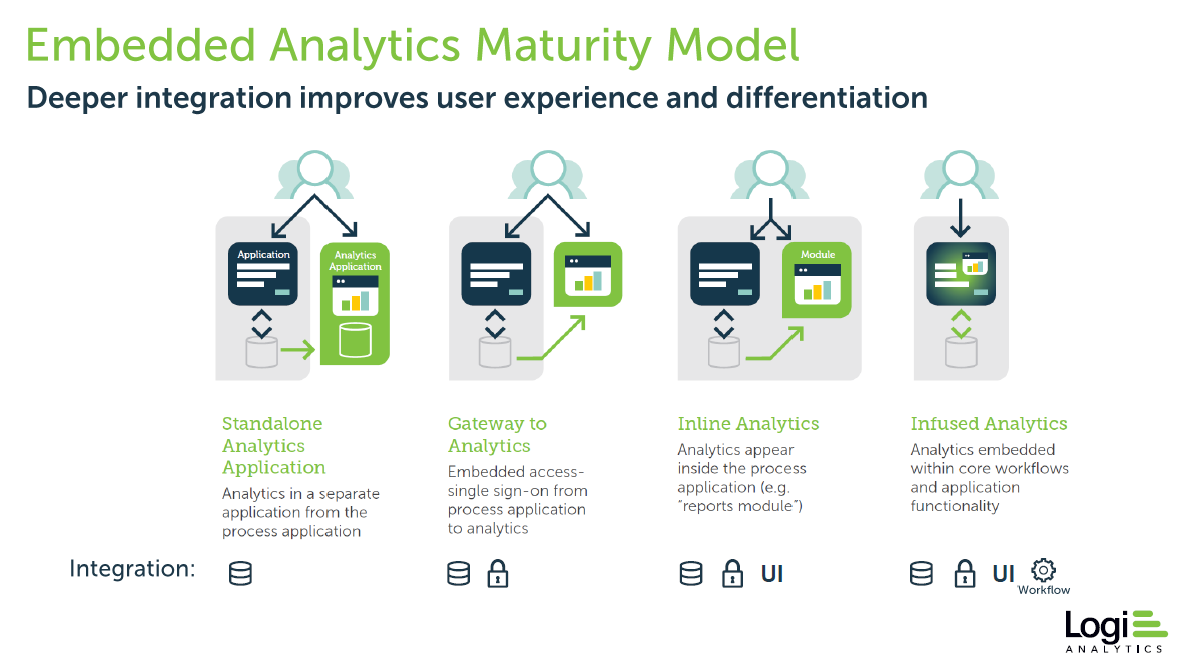What is embedded analytics and why it’s a buzzword in today’s business world? Embedded analytics is the integration of business intelligence into business applications. This smartens up the existing applications with powerful analytics and reporting features.
Deeper integration improves user experience
There is no reason to question the capabilities of embedded analytics integrated with the business applications. Embedding real-time analytics into business operations can significantly help. We saw it in the past, how embedded analytics thrived as the top business strategy to drive greater customer satisfaction and end user experience. The current scenario is no different as analytics continues to prosper as the core capability of a business operation. And, the future graphs show an upward trend as a multitude of existing users want deeper integration of analytics into their business applications sooner or later.
The deeper the integration, the higher the advantage
Businesses are already convinced that embedded analytics can play a part in bringing greater advantages. The mantra is, the deeper the integration, the higher the advantage! Usually, analytics is embedded within the core workflows and application functionality. Integrating more analytics into the parent application steadily increases the user experience. It ensures a progressive workflow for the users to have deeper insights on their actions by deriving accurate conclusions. It may give them some genuine statistics which helps them to be clear about the areas they need to work on and identify appropriate ways to increase the productivity. Deeper integration is not only revolutionizing the B2C application scenario but it is also making a difference in the way B2B applications are functioning.
One of the notable benefits derived from deeper integration is its increased user adoption. The features have become far more user-friendly and more interesting for the users and as a result the user adoption rate has significantly increased. The users agree that the analytics look as a natural part of their application and offering necessary information at the right point of time. One of the popular examples of this natural analytics is Amazon’s product reviews and suggestions provided at the side of Buy Now button.
Logi Analytics’ Embedded Analytic Maturity Model

Data democratization
Gone are the days when there were only a few people in the organization who needed analytical tools and they were obviously the data experts. Now that the scenario has endured 360 degree changes, embedded analytics is for everybody and can be accessed everywhere. Doesn’t this scenario lead to a better user experience? Of course it does. As part of growing IT adoption, there is a huge rise in self-service including self-analytics. The involvement of non-technical users in data analysis steadily increased as they started using the capabilities of analytics now. Most interestingly, they are very thrilled and want more of it.
Considering this fact, now every business application is including analytics features. The applications are on the way to enable more advanced data analysis through infused analytics. The in-built controls will make data utility a cake walk for many novices. Data democratization literally made the workforce to independently analyze the data and efficiently do their tasks. Having control over the analytical output makes them feel good and also promote greater employee engagement.
Predictive and prescriptive analytics
Both predictive and prescriptive analytics thrive on the concept of predictive and proactive solutions based on a variety of relevant business situations. Not many of the applications have these analytics power; however, they are slowly coming to the fore as people realize its ability to inform what the future holds for them along with its prescriptions.
When predictive analytics guides to mold the future events, prescriptive analytics informs the user what are the impacts of their actions on their business and guide them to possible solutions. According to a recent report by Gartner, currently only 3% of companies are using prescriptive analytics software compared to 30% users of predictive analytics. However, the expectation is that due to the growing significance of data and analysis in business, the adoption rate of prescription analytics will increase in the coming years.
Conclusion
The importance of embedded analytics grows steadily as it evidently revolutionizes the business operations with its greater ability to take better decisions. On the top of all, the data and analytics have become more available to everyone. This is not only making the people feel highly engaged in their work but turning them into confident decision makers as well!
image source: logi analytics
Embedded analytics – Here are the reasons why you cannot ignore it completely

Need Help?
We are here for you
Step into a new land of opportunities and unearth the benefits of digital transformation.
Related Insights
Blogs
Mar 4, 2024
5
min read







